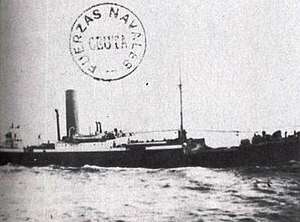SS Castillo de Olite
The Castillo de Olite was a merchant steamship, which was sunk by the coastal defense batteries of Cartagena in the last days of the Spanish Civil War, while transporting 2,112 Spanish Nationalist troops.
 Official photo of Castillo de Olite | |
| History | |
|---|---|
| Name: |
|
| Builder: | Rotterdam Droog (Netherlands) |
| Launched: | 1921 |
| Acquired: | 31 May 1938 |
| Stricken: | Sunk by shore batteries while entering the port of Cartagena on March 7, 1939 |
| General characteristics | |
| Class and type: | Merchant |
| Tonnage: | 3,545 grt |
| Length: | 110 m (360 ft 11 in) |
| Beam: | 16 m (52 ft 6 in) |
| Draft: | 6 m (19 ft 8 in) |
| Speed: | 10 knots (19 km/h; 12 mph)+ |
History
This ship was built in 1921 by Rotterdam Droog in the Netherlands. Her first name between 1921 and 1929 was Zaandijk, and she served as a merchant ship in the Dutch company Solleveld Van der Meer & T.H. Van Hattum, transporting goods to Java and Sumatra.
The ship was sold and renamed Akedemik Paulo between 1929 and 1932, and then resold to Nederlandsch Lloyd, which renamed it to Zwaterwater, where she served between 1932 and 1936.
In 1936 she was sold to the Soviet Union, where she was renamed Postishev in honor of a Ukrainian communist politician, Pavel Postyshev.[1] On 31 May 1938, she was seized in the Strait of Gibraltar by the Nationalist auxiliary cruiser Vicente Puchol, while transporting a shipment of coal.[2]
She was incorporated in the Nationalist Spanish Navy as the Castillo de Olite, and armed with a 120 mm Vickers gun and a 57 mm Nordenfeldt gun.[1]
Sinking
In the last days of the Spanish Civil War, Cartagena was one of the last Republican strongholds, which still harboured the bulk of the Republican fleet. When an anti-communist rebellion broke out, the Nationalists decided to send reinforcements, because the conquest of Cartagena and the capture of the Republican fleet would certainly bring the end of the war much closer.
The Nationalists sent from Castellón and Málaga a convoy of 16 ships, containing more than 20,000 troops, with less than 48 hours preparation. The convoy was composed by the Júpiter class minelayers Júpiter, Marte and Vulcano, the auxiliary cruisers Lázaro, Jaime I, Domine and J.J. Sister and the transports Castillo de Olite, San Sebastián, Castillo Peñafiel, Gibraltar, Monforte, Mombeltrán, Huertas, Montealegre and Simancas.[2]
The Republican fleet had effectively left Cartagena for Oran, in Algeria, but the Republican Brigade 206 had retaken the port and its coastal defense batteries, thus preventing the Nationalist landing.
The Nationalist ships retreated, except for the Castillo de Olite, which had not received the order to withdraw, because her radio was out of order. While approaching the docks, she was hit by one 152mm round[3] from a coastal battery and sank shortly afterwards, broken in two.[4]
Of the 2,112 men on board, 1,476 died, 342 were wounded and 294 were taken prisoner, after being rescued by local fishermen and the lighthouse keeper, Santiago Saavedra, and his wife, Carmen Hevia.[4]
This was the greatest loss of life from the sinking of a single ship in Spanish naval history.[5]
See also
- Cartagena Uprising
Notes
- Pérez Adán, Luis Miguel (2006). La Expedición sobre Cartagena y el hundimiento del Castillo Olite – Marzo de 1939 Archived 2011-07-20 at the Wayback Machine. Instituto Cartagenero de Investigaciones Históricas, pp. 6-8 (in Spanish)
- Fernández, p. 21
- Pérez Adán, p. 9
- Fernández, pp. 22-23
- Férnandez, p. 20
References
Fernández, Carlos (1999). Casi un crimen: el Castillo de Olite. La Aventura de la Historia magazine, issue #10. (in Spanish)